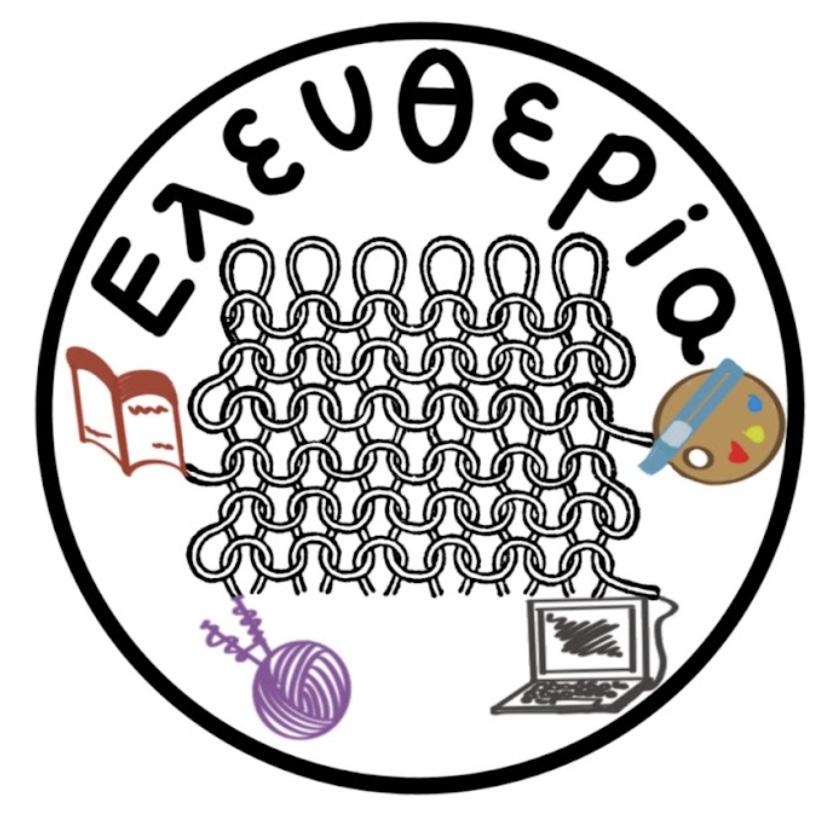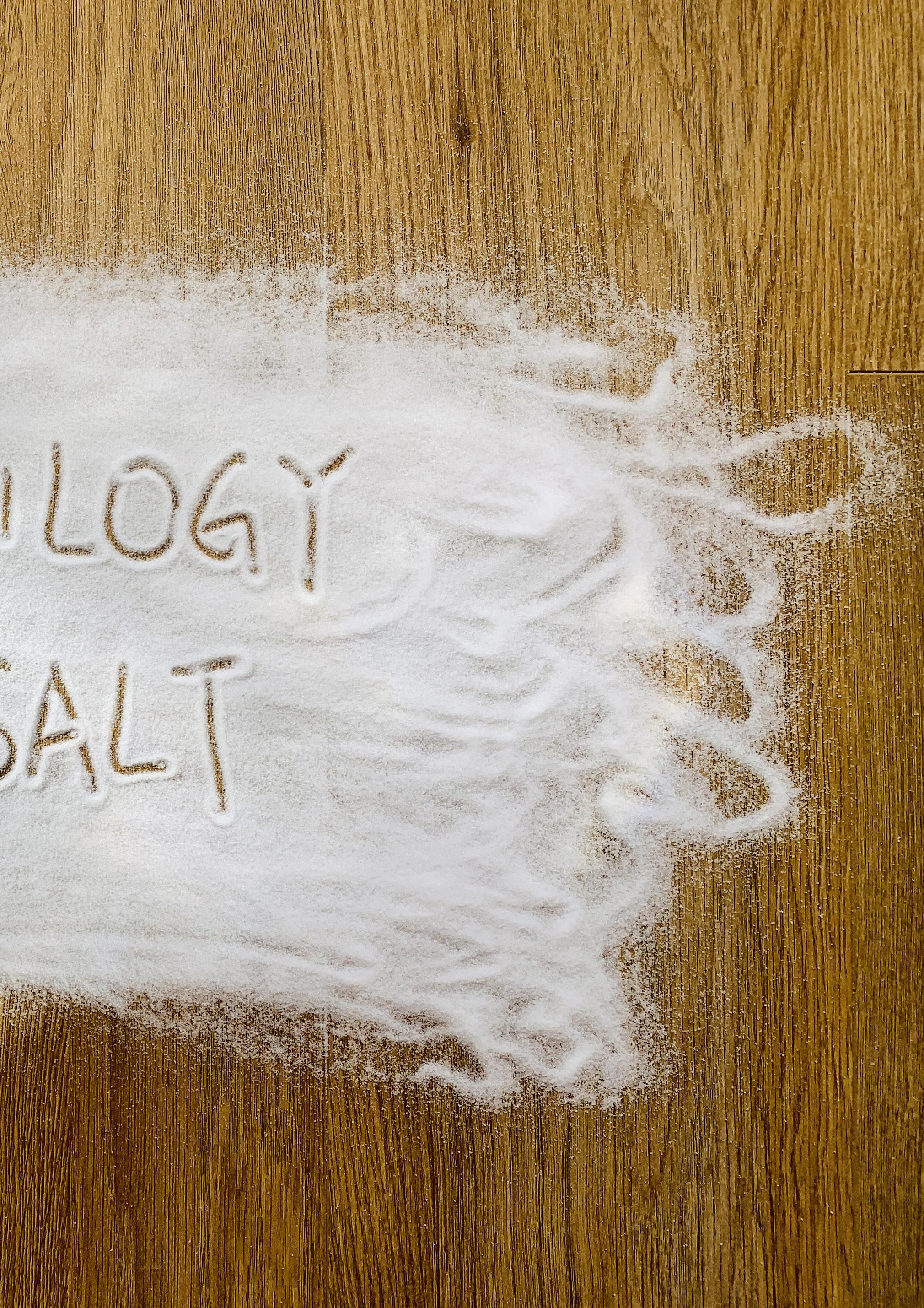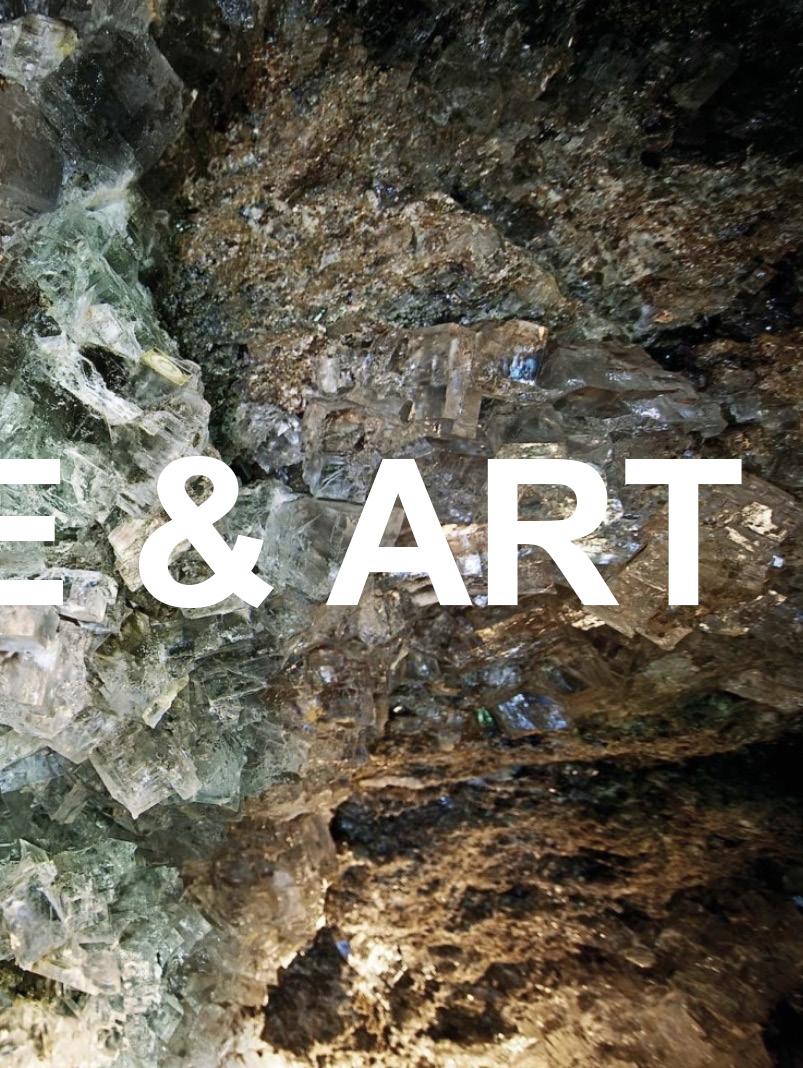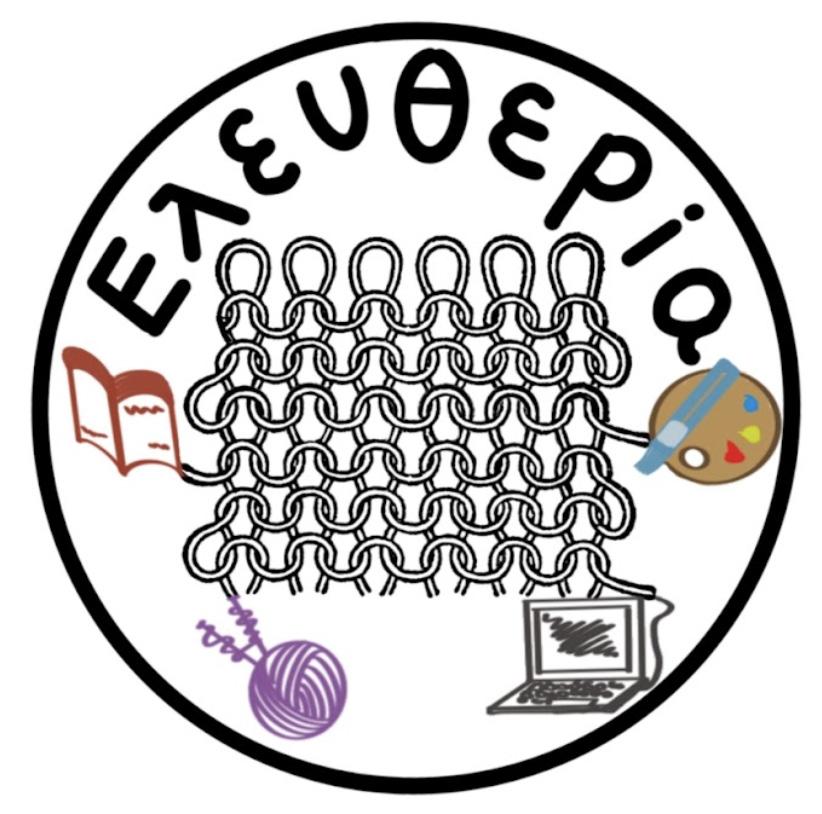
Royal College of Art
Academic Year 2023 -2024
Across RCA Climate 6
Team Eleutheria


Royal College of Art
Academic Year 2023 -2024
Across RCA Climate 6
Team Eleutheria



Group Name: Eleutheria
Tutor: Dr Spyros Bofylatos
Group Member:
Xinyue Zhang MA in Textile Design 10038893@network.rca.ac.uk
Pei Yi Tsai MA in Painting 10035554@network.rca.ac.uk
Daniel Gomez Freile MA in Print 10011416@network.rca.ac.uk
Luxi Duan MA in History of Design 10030774@network.rca.ac.uk
Content
A pinch of salt
Manifesto Page 6
Inescapable by Pei Yi Tsai Page 10
The salt of the earth by Xinyue Zhang Page 14
Global warming by Daniel Gomez Freile Page 18
The trilogy of salt Page 20
Epilogue Page 43



Climate changes is not a question of the future; it is an ongoing crisis in the current world. While it can be argued that there is global concern in how to tackle the challenge collectively, this project takes a different approach, by focusing on the climate issue from the lens of individualism; thus, how an artist or a designer can contribute to the climate crisis through artwork and design.
Art and design are generally a two-way interaction; the artist and designer’s purposes are embedded in the artwork and designed object, although the emotions expressed are reactions based on the viewer’s personal and consume experiences. Every single piece of art and design determines the uniqueness of feeling and reflection.
In terms of global climate change, all crisis’s definitions can be individualised. While governments set professed environmental standards and the United Nations can decide on climate change indices, this kind of standardisation does not represent and reflect the climate crisis entirely; in the opposite, the crisis depends on the individual’s geographical location, cultural background and living standards.
What do art and design mean to climate change? Every artwork and designed piece are unique in triggering emotions and documenting history. Artists and designers carry a duty of care and responsibility towards the climate crisis, and their creativity needs to advocate the resonance and awareness of climate change, even maybe the solution can only be achieved by few generations.

This group name has been defined as ‘Eleutheria’, the Liberty goddess in the ancient Greek. As the four group members are from completely different art and design disciplines, with distinct cultural backgrounds, however, there is a shared belief: freedom. A freedom to create artwork and design, and a freedom to speak out about the climate crisis. The other shared faith is that mankind’s desire to change nature, co-live with nature, benefit from nature, is a topic for all humanity The need to think and act as ancestors for future generations is significant: the worst catastrophes of climate crisis may occur in the future, but if action is taken now, we will also be the creators of the positive climate change consequences of the future.
In conclusion, it is hoped the research will inspire everyone, motivating artists and designers to use their creative power contributing to global climate change. The artwork and designed pieces are individualised, as each individual in the world has different emotions and perceptions of arts and designs. If every individual in the world collaborates and joins forces, could the world’s climate crisis be averted? The answer is Yes.

Title: Inescapable
Two Paintings
Size: 36 x 26cm
Acryllic on canvas
Pei Yi TsaiAs we delved into the narrative of “salt,” my research honed in on a specific case study – Montreal, Quebec, in Canada. Here, the city grapples with the environmental repercussions of heavily relying on salt for snow removal. The report illuminated the colossal efforts during the snow season, involving 3000 personnel and 2200 vehicles hitting the streets for snow clearance. To combat freezing, an immense quantity of salt, totaling 150,000 tons, is scattered across the roads. However, the aftermath reveals a persistent issue: the salt lingers, mingling with melted snow, infiltrating water bodies, and ultimately contributing to soil salinization, posing a substantial threat to agricultural sustainability. Professor Babakoukteh from the University of Quebec in Montreal underscored the pervasive nature of this challenge, extending far beyond the confines of a single city or specific roadways.
By Pei Yi Tsai


Title: The Salt of the Earth
Size: 52 x52cm
Material: Yarn





Xinyue knitted with white yarn to simulate the process of salt crystallization. Each different piece of fabric represents a different concentration of salt intrusion, and each piece of fabric is also slightly damaged, which represents the fragile land ecology.











As a natural substance, salt has always been used by artists as a material in their creations. In ancient Egypt, a special kind of salt called natron was added to clay, enabling intricate patterns to be produced during the firing process, as a result of the chemical reaction of salt changing at high temperatures (Figures 1 & 2)


In medieval Germany from the 15th century onwards, salt was sprinkled into the kiln during the firing of porcelain, creating different textures on its surface. This technique was adopted during the 17th and 18th centuries in English ceramic production, with high-quality porcelain of a brown colour being named salt-glazed stoneware (Figures 3 & 4)


Since the advent of the modern era, artists have used salt as a substitute for pigment in their paintings, such as Motoi Yamamoto (Figures 5 & 6) Some artists have used salt as a raw material for the creation of sculptures, the most famous example being Sigalit Landau (Figures 7 & 8)




Salt lakes are also used as landscape art projects, of which the pioneer example is Robert Smithson’s ‘Spiral Jetty’ (Figure 9). Natural salt lakes and saline fields have become photographic destinations due to their vivid colours which create dreamlike realms and magical kingdoms (Figure 10 & 11)



Photography by Mike Theiss, Nat Geo Image Collection
New Scientist Magazine
The Wieliczka salt mine in Poland has been transformed into a museum resembling a royal palace (Figure 12); while the sale mine Salina Turda in Romania is used as an amusement park (Figure 13); and the underground Roman Catholic Cathedral of Zipaquira is built within the tunnels of a salt mine 200 metres underground in Colombia (Figures 14 & 15)




Salt is loved by mankind for its crystalline shapes, transparent form, and milky white colour, representing a natural wonder; it is an excellent agency for use by artists in their creations.



Salt is one of the most important flavourings for food; its main component is sodium chloride, which is an essential substance for the maintenance of normal development and metabolism in the human body. Sodium (Figure 16) plays an important role in daily health; its functions include transmission of the body’s balance of electrolytes, regulation of the balanced distribution of body fluid, contribution to the formulation of gastric acid, the increasing of appetite, and the maintenance of the normal circulation of blood

Salt has been used by mankind since time immemorial and is appreciated as a useful ingredient in the course of daily life. Following early eras, when salt was collected from natural resources and used to prevent food, the effect of preservatives was applied in ancient Egypt to prevent decay of the human body after death for the mummification process (Figures 17 & 18). Meanwhile, for thousands of years, salt has been used in medical treatment processes, such as cleaning wounds.


As an indispensable table condiment, precious salts of different kinds are sought after by consumers as luxury products; examples include Persian blue rock salt, Himalayan pink salt, Korean and Japanese bamboo salt, Japanese Hana flake sea salt, Icelandic black lava salt, and Asian Tibuok, also known as ‘Dinosaur’s Egg’ (Figures 19 & 20). The by-products of salt, such as the vessels which contain it, have become manifestations for the flaunting of wealth.


From medieval times, the design of containers for the storage of salt became increasingly elaborate in European countries; the prevalence of spices meant that salt and pepper were the first objects with which the upper classes competed in order to show off their opulence. The most prestigious salt cellar was created by Benvenuto Cellini between 1540 and 1543; (Figure 21) its extravagant design and remarkable production process transformed the consumption of salt and pepper into a noble and extraordinary concept.

In terms of material culture study analysis, the pursuit of expensive exotic salt and the luxury design of salt containers, the focal points were no longer the salt as an actual food seasoning, but on the accessories which stored it and the implicit meanings behind consumption behaviours, with the commodity being used to show off claimed refined tastes.




Humans have always used salt, although human-mediated salt pollution is a consideration that cannot be ignored in the current global environmental crisis. In the 2012 BBC documentary ‘Indian Ocean with Simon Reeve’. Episode five ‘From Sri Lanka to Bangladesh’ reports that salt has destroyed the country’s ecosystem by backing up seawater into the fields due to shrimp farming in Bangladesh along the Indian Ocean coast (Figure 22). In the documentary, a former rice farmer claims that he had no choice but to farm shrimp because neighbouring farmers chose to flood fields with seawater. His rice fields, positioned in the middle, inevitably became polluted and contaminated, rendering the land unsuitable for growing crops and forcing him to regretfully switch to prawn farming (Figure 23).


The documentary also featured some villagers who refused to engage in shrimp and prawn farming; their resistance to the financial temptation to import sea water in the first place resulted in a few surviving villages primitively continuing to grow rice in the region. Their village became a refuge for neighbourhood residents because they were the only ones who had retained fresh water in their wells for drinking, cooking, laundry and irrigation. When supermarkets in developed Western countries sell tiger prawns from Bangladesh, consumers are unaware that, on the other side of the world, there are people who have lost their rice fields and livelihoods forever due to the demand for this product.
Salt, as a compound, has other environmental side effects that can no longer be ignored; it has become a matter of urgency to consider salt pollution as an aspect of the climate crisis. The United Nations’ 2021 Global Symposium on Salt-affected Soils (GSAS21) advocated for the cessation of soil salinisation. Although naturally saline or sodic soils are home to important ecosystems, unsustainable human activities mean that secondary salinity and sodicity threaten agricultural productivity and the supply of vital ecosystem services, with
salinization and sodification having become the leading hazard for soils irrigated with wastewater in any climate zone.

Scientific studies also have proven that, when salt is introduced to water, it pollutes and inhibits the growth and ultimate survival of many aquatic organisms. The growing rate of global warming will lead to the evaporation of an increasing amount of water, thus creating more saline fields. The question of how to develop suitable regulations to monitor the salt damage situation throughout the world in order to accomplish the United Nations’ Sustainable Development Goals (SDGs) should be prioritised.

Illustration List (All accessed on 01 March 2024)
1. https://art.thewalters.org/detail/39843/malqata-kateriskos-vessel/
2. https://www.metmuseum.org/art/collection/search/551250
3. https://collections.vam.ac.uk/item/O341792/pitcher/
4. https://collections.vam.ac.uk/item/O10621/bottle-killigrew-william/
5. https://www.designboom.com/art/motoi-yamamoto-outlines-complex-labyrinths-table-salt-0323-2014/
6. https://www.designboom.com/art/motoi-yamamoto-outlines-complex-labyrinths-table-salt-0323-2014/
7. https://hezicohengallery.com/artists/sigalit-landau/
8. https://hezicohengallery.com/artists/sigalit-landau/
9. https://www.americanscientist.org/article/spiral-jetty
10. https://www.nationalgeographic.com/travel/article/how-to-see-salar-de-uyuni-salt-flats-bolivia
11. https://www.newscientist.com/article/2311507-red-and-purple-microbes-give-australiasmysterious-pink-lake-its-hue/
12. https://www.wieliczka-saltmine.com/individual-tourist/about-the-mine/chambers-spaceshollowed-out-in-salt-rock
13. https://www.salinaturda.eu/en/discover-the-turda-salt-mine/
14. https://www.mprnews.org/story/2019/04/20/npr-colombia-salt-cathedral
15.
16.
17.
18.
19.
https://www.tomorrow.city/zipaquira-salt-cathedral/
https://www.britannica.com/science/sodium
https://www.metmuseum.org/art/collection/search/587568
https://www.worldhistory.org/image/5399/anubis-egyptian-sarcophagus/
https://www.chefspencil.com/worlds-most-expensive-salts/
20. https://www.businessinsider.com/asin-tibuok-one-of-the-rarest-salts-in-the-world-20239?r=US&IR=T
21. https://www.khm.at/en/objectdb/detail/87080/
22.
https://www.bbc.co.uk/programmes/p00pqbfg
23. https://www.bbc.co.uk/programmes/p00pqbfg
24. https://www.fao.org/global-soil-partnership/gsasmap/en/
25. https://www.fao.org/global-soil-partnership/gsasmap/en/
Image Trilogy of Salt – photographed by Luxi
Three Title Images – photoshop edited by Luxi, based on original images https://www.wieliczkasaltmine.com/individual-tourist/about-the-mine/hidden-from-human-sight-crystal-caves


We are our history.
Humans and nature coexist on our blue planet. The natural world nurtures us, although humankind has, throughout our history, constantly sought to change the natural world on which we depend for our survival. In the process of constantly changing and adaption to nature, humans are also destroying the world in various ways and to different extents. The question of how humans can harmoniously and sustainably coexist with nature is critical for our long-term survival; the global climate crisis is everyone’s responsibility.
Nature, art and design are interesting and interrelated, developing interactive and inseparable relationships. As artists and designers, we constantly seek inspiration from nature, using natural materials to create art works and design pieces. In a sense, artists and designers are constantly reinterpreting and redefining our understanding of nature. Our natural world shapes us and places restraints on our life, while we seek to re-shape and change our natural environment on the planet.
After careful consideration of discussion, the topic of salt was selected as the final direction of our project because it is a natural substance which has existed throughout time, while sodium is an essential chemical element within the human body. Salt has existed on earth for millions of years, and the sea is full of salt elements; humans are born into a world which contains salt. Ironically, however, humans are carrying out harmful activities which create problem for our own living environment, such as salinizing soil.
In our team, Luxi presents a short essay ‘The Trilogy of Salt’, expounding the background of the project from the three perspectives of: nature and art, the necessary nutrient, and neglect element and negative effect. PeiYi uses two acrylics on canvas paintings to explore the beauty of salt, and the tragedy
of salt pollution, inspired by the Canadian report of gritting the roads with salts damaging the environment. Daniel shows his understanding of salt damage and the climate crisis from a poetic perspective through a literature piece. Xinyue has created a salt soft sculpture to illustrate her personal interpretation of the theme ‘The Salt of the Earth’.
All individual artists and designers are free to understand and interpret the climate crisis, using different methods of presentation. Typically, as four individuals from different backgrounds, we have devised our own unique works in response to the same topic. Within the group we focus on the freedom to create, to respect, to compromise, and to encourage each other; we have collaborated closely as a cohesive team, celebrated each other’s achievements and final outcomes, and appreciated each other’s contributions to the project.
We are creating history, we are changing history, and we are our own history! Therefore, everyone can use his/her/their own ways to make a contribution to environmental protection, in order to tackle the climate crisis.
Respecting freedom, individualism and creativity are vital principles for artists and designers within any campaign involving climate change. Our project journey is an excellent example of how individuals can use collaboration as a powerful weapon, and to effect change in the face of the global climate crisis.
We can make our own history. We are our history.
Thank You
